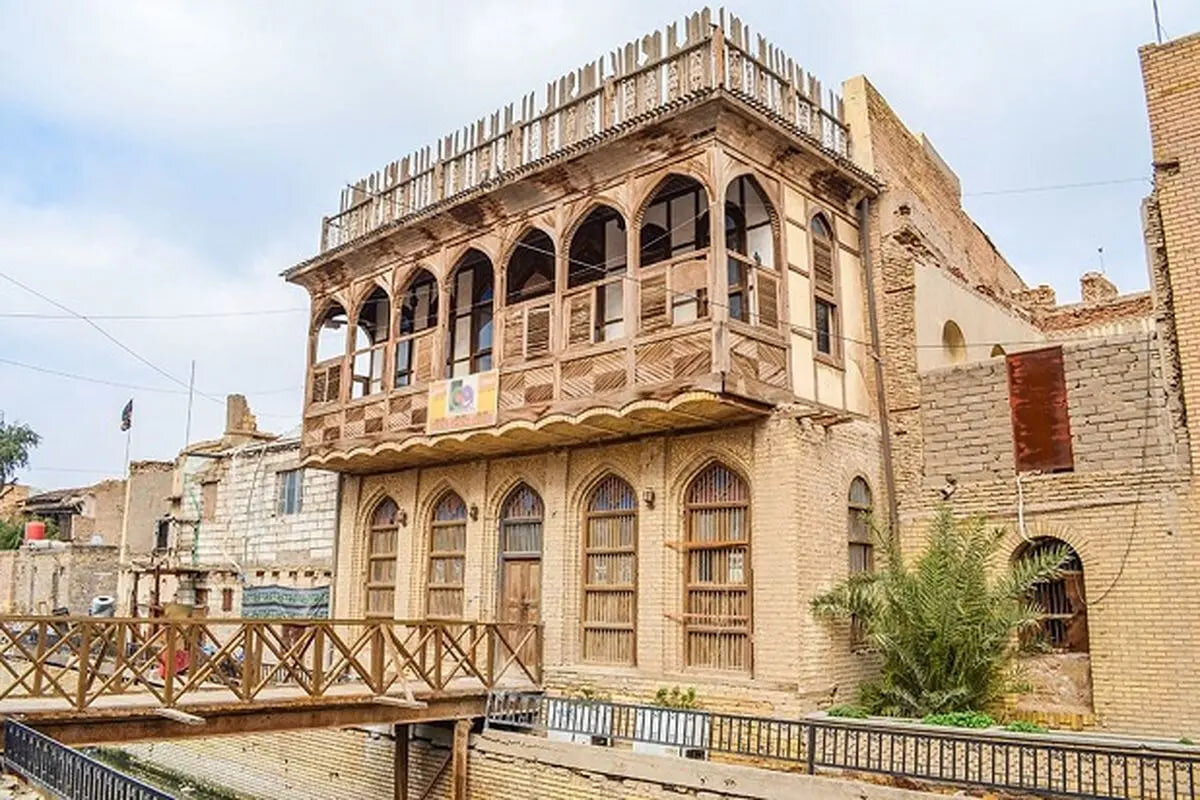Wooden balconies to be revived in Bushehr

TEHRAN--Wooden balconies (known as Shanashir) of historical houses have become the focus of attention of Bushehr Cultural Heritage Department.
Their counterparts in the city of Basra, Iraq, are known as Shanasheel. Studies have begun in Iran to register these practical elements in the traditional architecture of historical houses in Bushehr and Basra, ILNA reported.
The Bushehr Shanashirs are elements of the native architecture of the Persian Gulf coast, which are known as the architectural element of introversion and extroversion of traditional houses in this region. They are wooden panels with cut-out letters and words.
Iranian Shanashirs and Iraqi Shanasheels are shuttered wooden balconies that are installed in front of the windows of the upper floors of traditional houses, and their structure is such that light and air easily enter the building and guard the view of the houses. In such a way that from behind the wooden words, the outside space can be easily viewed, but there is no view of the inside of the houses from the outside.
Ali Mahini, a cultural heritage chief of Bushehr, called Shanashirs as the most remarkable indigenous architecture in the hot and humid climate of the region, which are of great importance in terms of aesthetics and functionality in historical monuments.
He said that according to the latest surveys of Bushehr Cultural Heritage Department, about 30 percent of the houses located within the historical texture of Bushehr are equipped with Shanashir.
He announced that among these houses, Tabib Mansion, Dehdashti Mansion, Golshan-e Irani Mansion and Behbahani Mansion have been registered in the country's National Heritage List, and documentation of other notable buildings is also underway so that other historical houses of Bushehr with wooden balconies can be gradually registered in the country's National Heritage List.
Referring to the condition of Bushehr's historical houses, he said: “In general, within the framework of the Bushehr historical texture restoration plan, protective measures have been taken to reduce environmental damage to the historical buildings, and some of the houses also require urgent restoration due to dilapidation and climatic conditions, and their restoration is on the agenda of Bushehr Cultural Heritage Department.”
Mahini referred to the similarity of the shuttered houses in the two port provinces of Bushehr and Basra, adding: The existence of historical and cultural roots between Bushehr and Basra in Iran and Iraq has led to the formation of many similarities in the traditional architecture of these two ports.
He said: The formation of the shuttered structure in traditional houses is actually the result of cultural and commercial interaction between the people on both sides of the Persian Gulf in past centuries.
Referring to the potential for global registration of shuttered wooden balconies as a common architectural heritage of Iran and Iraq, he said that from a technical and legal perspective, there is a possibility of transnational registration of this type of architecture as a common heritage of Iran and Iraq.
Mahini emphasized that a preliminary study to prepare a file for possible registration of Bushehr Shanashirs on UNESCO World Heritage List is on the agenda of Bushehr Cultural Heritage Department, and in coordination with the Iraqi side, traditional wooden shuttered balconies can be presented in the form of a joint file between the two countries.
Regarding the restoration and revival of historical houses and installation of Shanashirs in the historical texture of Bushehr, several key programs are being implemented in Bushehr Cultural Heritage Department, the first of which is to encourage private investors to restore and upgrade traditional houses into eco-tourism residences.
He added that another issue is organizing educational and cultural tours focused on visiting houses with Shanashirs.
According to Mahini, the scientific documentation of architectures with Shanashirs in cooperation with the Persian Gulf University is also another program of Bushehr Cultural Heritage Department to promote the use of this traditional architectural heritage.
He announced the production of educational and research content to introduce Shanashirs as a model of sustainable architecture in a hot and humid climate as another program of Bushehr Cultural Heritage Department.
Mahini continued that Shanashir is part of the historical and cultural identity of Bushehr and a symbol of the connection between the people of this region and the sea and the climate. The preservation, restoration and introduction of this valuable element in the traditional architecture of the Persian Gulf coast is an important step in preserving the cultural heritage of the Persian Gulf coast and moving towards its global registration, he added.
At end, he expressed hope that the programs currently underway to restore, revive and introduce the importance of using the Shanashir element in the architecture of Bushehr Province will not only preserve this architectural heritage of the Persian Gulf coast in Iran and the shared architectural heritage with the city of Basra in Iraq, but also promote its use in the modern lives of the people of Bushehr and revive this architectural heritage in the traditional buildings of Bushehr.
KD
